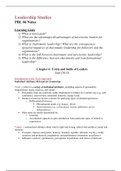Leadership Studies
PBL #6 Notes
Learning Goals
1) What is narcissism?
2) What are the advantages/disadvantages of narcissistic leaders for
organizations?
3) What is charismatic leadership? What are the consequences
(positive/negative) of charismatic leadership for followers and the
organization?
4) What is the link between charismatic and narcissistic leadership?
5) What is the difference between charismatic and transformational
leadership?
Chapter 6: Traits and Skills of Leaders
Yukl (2013)
Introduction to the Trait Approach
Individual Attributes Relevant for Leadership
Trait refers to a variety of individual attributes, including aspects of personality,
temperament, needs, motives, and values
Personality traits are relatively stable dispositions to behave in a certain way (e.g. self-
confidence, extroversion, emotional maturity, energy level)
Needs (or motives) involve a desire for particular types of stimuli/experiences
o Differentiated between:
Physiological needs (e.g. hunger, thirst)
Social motives (e.g. achievement, esteem, affiliation, power,
independence)
Most traits are jointly determined by:
o Learning
o An inherited capacity to gain satisfaction from particular types of stimuli or
experiences
Values internalized attitudes about what is right and wrong, ethical and unethical, moral and
immoral
Examples: fairness and justice, honesty, freedom, equality, altruism, loyalty, civility
(courtesy and politeness), pragmatism, and performance orientation (excellence)
Influence a person’s preferences, perceptions of problems, and choice of behavior






